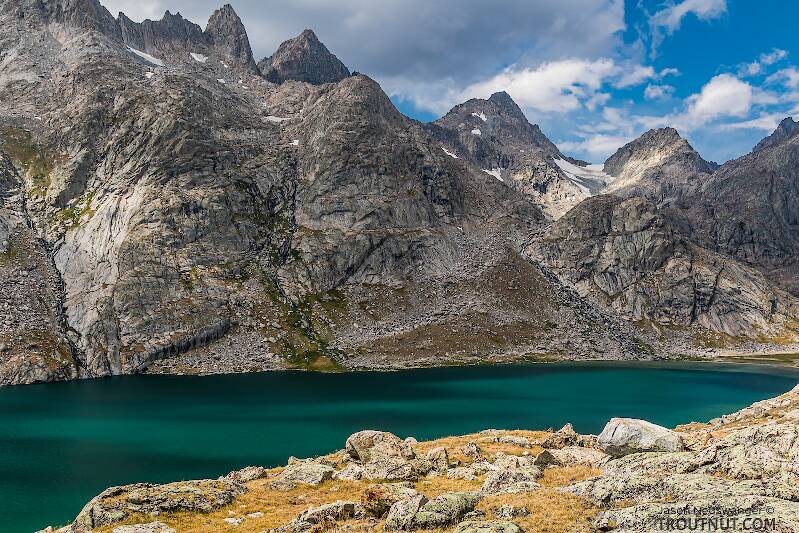
Salmonflies
Pteronarcys californica
The giant Salmonflies of the Western mountains are legendary for their proclivity to elicit consistent dry-fly action and ferocious strikes.


Mayfly Species Ephoron album (White Flies)
Taxonomic History
"Among the objects which chiefly attracted our notice, were the interesting ephemera which we had seen on Winnepeek Winnipeg] River. They became go abundant on Rainy R. toward sunset, that they presented the appearance of a snow storm. They continued for some time, until they were driven by the wind into a small tributary valley where they formed white clouds, beautifully relieved against the
dark green of the forest, deepened in its shade by the approach of night. The ensuing morning their dead bodies were seen floating on the stream, and drifted by the wind into small coves near the shore. From their great abundance, Mr. Say was led to believe that this short-lived insect never witnesses a rising sun, but that after each performance, in a short time, all the duties assigned to it in its perfect state, it deposits its egge and expires in the night, a few hours after it has been evolved from the chrysalis. The next evening the ephemera were again seen very abundantly, but it was evident that this was a new swarm, and not a part of that previously observed." (Keating, 1824).
Where & when
This is the only Ephoron species in the West, where it is known from the large rivers near Yellowstone National Park. It is abundant in the Midwest, and it is present in the East but not to the extent of Ephoron leukon.In 28 records from GBIF, adults of this species have been collected during July (43%), August (29%), September (21%), and June (7%).
In 31 records from GBIF, this species has been collected at elevations ranging from 618 to 6250 ft, with an average (median) of 3533 ft.
Species Range
Physical description
Most physical descriptions on Troutnut are direct or slightly edited quotes from the original scientific sources describing or updating the species, although there may be errors in copying them to this website. Such descriptions aren't always definitive, because species often turn out to be more variable than the original describers observed. In some cases, only a single specimen was described! However, they are useful starting points.
Male Spinner
Wing length: 11–12 mm
Vertex of head yellowish brown with purplish markings; mesonotum light yellowish brown; veins of costal margin of fore wing purplish grey, all others pale. Face pale yellowish; second basal joint of antenna dusky at apex, filament whitish. Eyes black. Vertex of head yellowish brown, marked and sometimes almost obscured by purplish shading; darkest between ocelli, which are heavily dark-ringed at base. Pronotum yellowish; pleura with purplish grey streaks above leg base. Mesonotum yellow, tinged with yellowish brown on each side of median area; scutellum pale yellowish. Metanotum yellowish brown. Pleura and sternum pale yellowish, the former often tinged with yellowish brown. Fore femur and tibia purplish; femur marked with yellowish white along ventral edge; ventral edge of tibia whitish at extreme base; tarsus smoky grey at base, becoming silvery white apically. Middle and hind legs pale yellowish white. Wings rather semi-hyaline, with faint purplish tinge along the costal border. Longitudinal and cross veins of costal margin purplish grey, cross veins somewhat darker than longitudinals; as far back as the anterior branch of media, the cross veins are faintly greyish; all other veins of both wings colorless. Abdomen pale yellowish white, basal and middle segments often semi-hyaline; apical tergites yellowish. Genitalia pale (see fig. 78). Tails pale smoky at base, becoming whitish apically; joinings opaque whitish.
Discussions of Ephoron album
Start a Discussion of Ephoron album
References
- Arbona, Fred Jr. 1989. Mayflies, the Angler, and the Trout. Nick Lyons Books.
- Caucci, Al and Nastasi, Bob. 2004. Hatches II. The Lyons Press.
- Needham, James G., Jay R. Traver, and Yin-Chi Hsu. 1935. The Biology of Mayflies. Comstock Publishing Company, Inc.
Mayfly Species Ephoron album (White Flies)
Species Range
Common Names
Resources
- NatureServe
- Integrated Taxonomic Information System
- Global Biodiversity Information Facility
- Described by Say (1824)

